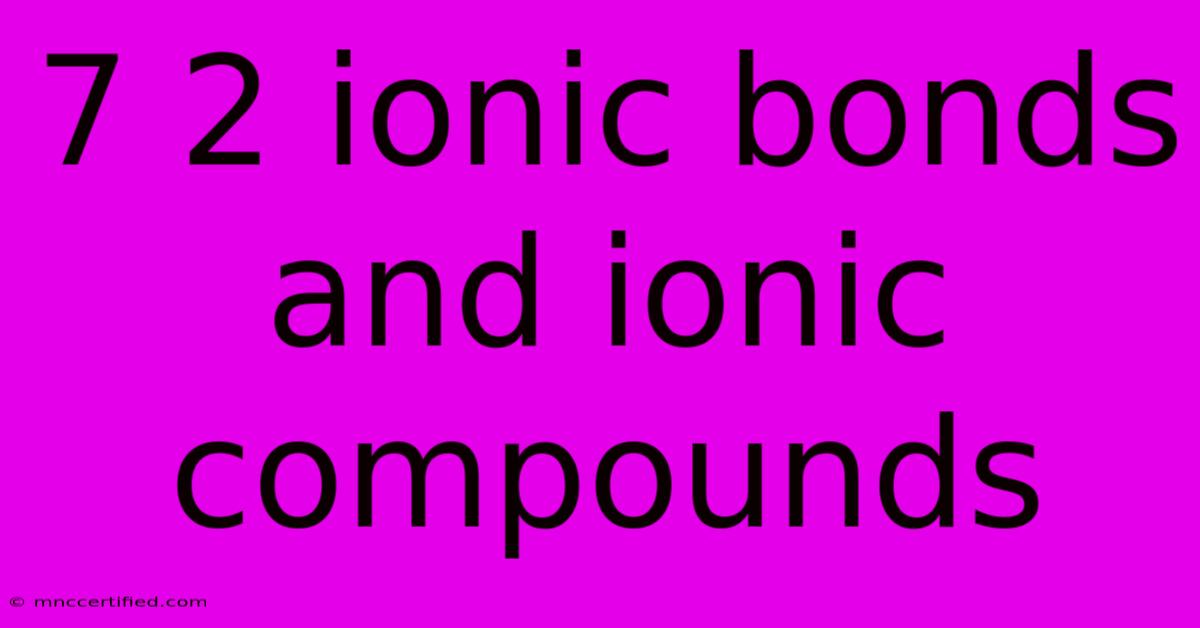7 2 Ionic Bonds And Ionic Compounds

Table of Contents
Delving into the Realm of Ionic Bonds and Compounds: A 7-Step Guide
Ionic bonds are fundamental to understanding the structure and properties of a vast array of compounds. These bonds arise from the electrostatic attraction between oppositely charged ions, creating a unique and fascinating world of chemical interactions. In this article, we will explore the intricate dance of ionic bonds, unraveling the key concepts and characteristics of ionic compounds.
1. Understanding the Basics: What is an Ionic Bond?
At its core, an ionic bond is a type of chemical bond that involves the transfer of electrons between atoms. This transfer results in the formation of ions, which are atoms with a net positive or negative charge. The positively charged ions are called cations (formed by losing electrons), while the negatively charged ones are called anions (formed by gaining electrons).
2. The Driving Force: Electrostatic Attraction
The fundamental force that holds ionic compounds together is electrostatic attraction. This attraction arises from the opposite charges of cations and anions. Just like opposite poles of magnets attract each other, cations are drawn to anions, forming a strong bond that keeps the compound intact.
3. Formation of Ions: Metals and Nonmetals
Ionic bonds typically form between metals and nonmetals. Metals tend to lose electrons easily, becoming cations, while nonmetals readily gain electrons to form anions. This tendency arises from the differences in their electronegativity – the ability of an atom to attract electrons.
4. Examples of Ionic Compounds: NaCl (Sodium Chloride)
A prime example of an ionic compound is NaCl, commonly known as table salt. Sodium (Na), a metal, loses one electron to become a positively charged sodium ion (Na⁺). Chlorine (Cl), a nonmetal, gains this electron to become a negatively charged chloride ion (Cl⁻). The electrostatic attraction between Na⁺ and Cl⁻ forms the strong ionic bond in sodium chloride.
5. Properties of Ionic Compounds: High Melting and Boiling Points
Ionic compounds exhibit distinctive properties due to the strong electrostatic interactions between ions. They typically have high melting and boiling points, requiring significant energy to overcome the strong ionic bonds. This is why table salt melts at a much higher temperature than sugar, which is held together by weaker bonds.
6. Solubility: The Role of Polar Solvents
Ionic compounds often dissolve in polar solvents like water. The polar nature of water molecules allows them to surround and separate the ions, disrupting the ionic lattice and dissolving the compound. This explains why table salt readily dissolves in water.
7. Electrical Conductivity: Conductors in the Molten State
While solid ionic compounds are generally poor conductors of electricity, they become excellent conductors when melted or dissolved. This conductivity arises from the free movement of ions when the rigid lattice structure is disrupted. This principle underlies the use of molten salts in certain electrochemical processes.
Conclusion: Ionic Bonds – A Foundation of Chemistry
Ionic bonds play a pivotal role in chemistry, shaping the structure and properties of a vast array of compounds. By understanding the transfer of electrons, the electrostatic attraction, and the resulting properties of ionic compounds, we gain a deeper appreciation for the fundamental building blocks of our world.

Thank you for visiting our website wich cover about 7 2 Ionic Bonds And Ionic Compounds. We hope the information provided has been useful to you. Feel free to contact us if you have any questions or need further assistance. See you next time and dont miss to bookmark.
Featured Posts
-
Are Gevril Watches A Good Investment
Nov 12, 2024
-
Dolphins Rams Week 10 Preview 4 Key Matchups
Nov 12, 2024
-
Trump Picks Zeldin For Epa Leadership
Nov 12, 2024
-
Fc Barcelona Handball Catalan Federation Award Winners
Nov 12, 2024
-
Dogecoin And Bitcoin See Price Increases
Nov 12, 2024